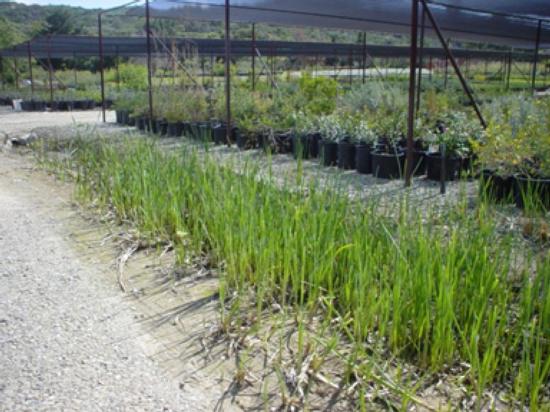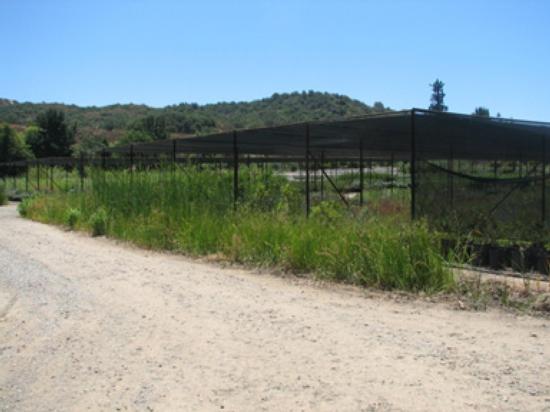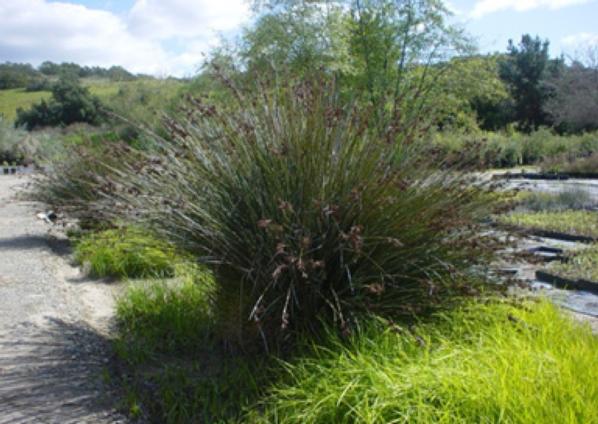GET CULTURED: Drainage channels and vegetated filter strips in nurseries Part II
by Don Merhaut and Lea Corkidi
Vegetated and non-vegetated drainage channels can be used to remediate the negative environmental effects of storm water and irrigation water runoff that may occur from agricultural production. In the previous newsletter, we addressed important considerations for the construction of non-vegetated drainage channels. This article focuses on vegetated filter strips, one of the available Best Management Practices to improve the quality of runoff water.
Filter strips are bands of vegetation intentionally planted between agricultural production areas and waterways to intercept sediment and absorb pesticides and nutrients. As runoff water moves across the vegetated strips, the water is filtered by physical, biological and chemical processes (fig. 1). Roots and rhizomes obstruct flow, facilitate sedimentation and provide surface area for microbial activity. Nutrients and pesticides are taken up by plant root systems, decomposed by microorganisms or adsorbed into soil particles.

Fig. 1. Filter strips can be used in the nursery to protect nearby waterways. As runoff water flows across the vegetated strip, the water is filtered by physical, biological and chemical processes. The filter strip in this photo was established at Tree of Life Nursery in San Juan Capistrano, California.
Different studies have compared vegetated and non-vegetated systems for wastewater treatment and have emphasized the key role of plants in pollutant removal. Plants are known to influence the removal of pollutants either directly through assimilation or indirectly through their influence on microbial activity. However, the effectiveness of vegetative filter strips depends on many factors, such as slope, runoff flow, climate, soils, plant size and vegetation cover, and plant species. There are a few key considerations when planning and establishing a filter strip: (1) site selection, (2) filter strip design, (3) plant selection, (4) plant establishment practices, and (5) maintenance.
Site Selection
It is ideal to select a site that already is conducive to channeling runoff; otherwise, site preparation such as grading and addition of soil amendments may be required. Filter strips should be planted on gently sloping sites so that water flows slowly through the filter strip to allow optimum absorption of nutrients and pesticides before the water flows out of the filter strip. Slopes that are too steep are subject to erosion; slopes that are too flat will result in standing water that will be low in oxygen, causing odors and accumulation of organic matter. Existing natural habitat and endangered species also need to be considered when selecting the site.
Filter Strip Design
Many factors must be considered in developing a good filter strip design. One of the most important factors is the size of the filter strip, which should accommodate the normal flows of nursery runoff and runoff from storm events. When designing a filter strip, it is best to consult a licensed engineer or the Natural Resources Conservation Service (NRCS). Filter strips need to be designed and constructed to comply with all federal, state, and local laws and regulations.
Plant Selection
A large number of species can be suitable for filter strips, including trees, shrubs, and cool season and warm season grasses as well as herbaceous rhizomatous perennials. It is important to select plants that withstand the particular characteristics of the area (e.g., plant hardiness, heat tolerance) because the nutrient removal efficiency varies in different environmental conditions. Site conditions that may need to be considered include soil type, depth to water table and seasonal rainfall (especially if supplemental irrigation is not planned for dry seasons), and conditions of standing water and low root aeration.
Plant qualities that have been considered important to improve the efficiency of nutrient removal include large biomass and tolerance to salt, drought and flooding. High transpiration rates and ability to enhance microbial populations are also important.
Wetland plant species have widely been included for waste water treatment because of their abilities to accumulate nitrogen and phosphorus. Many of these species tolerate different periods of soil inundation but can also survive the summer drought, which are common conditions experienced in filter strips in Southern California. Different species of cattails (Typha spp.) and bulrushes (Schoenoplectus spp.) (fig. 2), rushes (Juncus spp.) (fig. 3), sedges (Carex spp.), and grasses and other herbaceous perennials have been used as water purifying plants. Some species of these plants are known to remove nutrients and bacteria and accumulate heavy metals.

Fig. 2. Vegetated filter strip with different species of bulrushes (Schoenoplectus spp.) and cattails (Typha spp.) at Tree of Life Nursery in San Juan Capistrano, California. Establishing and maintaining a diverse plant community allows a more complete use of resources.

Fig. 3. Rushes (Juncus spp.) are commonly used in filter strips. This photo shows Juncus acutus at Tree of Life Nursery in San Juan Capistrano, California. Image by Mike Evans.
However, the rate of nutrient uptake varies widely among different species, depending on the plant growth rate and nutrient concentration in plant tissue. Plant growth during seasonal storms is important in the uptake of pollutants generated during these events. Plants that grow rapidly are easier to establish and can take up more nutrients from runoff, but pruning, mowing and other maintenance issues associated with rapid growth need to be considered. In addition, when plants are mowed or pruned severely, the water and nutrient uptake capacity is reduced until new vegetative growth is established.
When filter strips are used in natural areas, as is common in agriculture, it is preferable to use native plant species that blend with existing vegetation. Table 1 includes a list of California native plants that could be suitable for vegetated filter strips. The incorporation of local native species also provides a sustainable habitat for native wildlife.
Table 1. California Native Plants for Vegetated Filter Strips
|
Family |
Scientific Name Common Name |
Size |
Flowering Season |
Plant General Characteristics1 |
|
Cyperaceae (Sedge Family) |
Carex obnupta Slough Sedge |
2-5 ft. tall |
Spring |
Grass-like perennial. Salinity tolerant. |
|
Carex pansa California Meadow Sedge |
6-8 in. tall x 3 ft. wide |
Spring |
Grass-like, low creeping perennial. Tolerates foot traffic. |
|
|
Carex praegracilis Clustered Field Sedge |
1 ft tall x spreading |
Spring/Summer |
Clumping grass-like perennial. Grows in alkaline places. |
|
|
Carex senta Swamp Sedge/Rough Sedge |
1-3ft tall x 3ft. wide |
Spring |
Low clumping, grass-like perennial. Tolerates alkaline soil and foot traffic. Stress deciduous. |
|
|
Carex spissa San Diego Sedge |
5 ft. tall x 3-4 ft. wide
|
Winter/Spring |
Large clumping, grass-like perennial.
|
|
|
Carex tumulicola Berkeley Sedge/Foothill Sedge |
10 in. tall x 3 ft. wide |
Spring |
Low clumping, arching, grass-like perennial. Drought tolerant, survives foot traffic. |
|
|
Eleocharis macrostachya Spike Rush |
3ft tall x 2 ft wide |
Spring |
Low evergreen herbaceous perennial. |
|
|
Eleocharis montevidensis Sand Spikerush |
1-2 ft tall x 2-3 ft wide |
Summer |
Spreading herbaceous perennial. Tolerates heavy clay soils. |
|
|
Schoenoplectus2 americanus American Bulrush |
1-4 ft tall x 2-5 ft wide |
Spring |
Erect herbaceous perennial. |
|
|
Schoenoplectus2 californicus California Bulrush |
1-5 ft tall x spreading |
Spring/Summer |
Herbaceous perennial. Summer dormant. |
|
|
Schoenoplectus2 maritimus Alkali Bulrush |
1-4.5 ft tall x spreading |
Spring/Summer |
Grass-like perennial. Can grow submerged in water. Winter dormant. |
|
|
Juncus mexicanus Mexican Rush |
2 ft tall x spreading
|
Spring |
Upright spreading rush. |
|
|
Juncus patens Common Rush/California Grey Rush
|
2 ft tall x spreading |
Summer |
Evergreen perennial rush with upright to slightly arching stems. Prefers moist places but tolerates drought once established. Dormant without summer irrigation. |
|
|
Juncus xiphioides Irisleaf Rush |
1 ft tall x spreading |
Summer |
Low spreading, evergreen rush. |
|
|
Onagraceae (Evening Primrose Family) |
Oenothera elata ssp. hookeri Marsh Evening Primrose |
1-4 ft. tall x 1-2 ft. wide |
Spring/Summer |
Herbaceous erect perennial. Large yellow flowers with 4 petals attract moth pollinators. |
|
Poaceae (Grass Family) |
Elymus trachycaulus Slender wheatgrass |
2-21/2 ft tall |
Spring |
Erect, cool season perennial bunchgrass. |
|
|
Hordeum brachyantherum Meadow Barley/California Barley |
6 in. to 2 ft tall |
Late Spring/Early Summer |
Cool season, perennial bunchgrass. |
|
Leymus triticoides Creeping wildrye |
2-3 ft. tall x spreading |
Summer |
Perennial grass, drought tolerant. Tolerates foot traffic. |
|
|
Muhlenbergia rigens Deergrass |
2-4ft. tall x 4 ft. wide |
Summer |
Perennial warm season bunchgrass. Tolerates periodic flooding and drought once established. |
|
|
Sporobolus airoides Alkali Sacaton |
2-3 ft tall |
Summer |
Perennial warm season grass. |
|
|
Scrophulari- |
Mimulus guttatus Golden Monkey flower |
2 ft tall x spreading |
Spring/Summer |
Annual or perennial herb with yellow flowers spotted with red dots, deciduous. |
|
Typhaceae |
Typha spp. Cattail |
10 ft tall x spreading |
Spring |
Upright, spreading, herbaceous perennial. Winter dormant. Excellent for erosion control. |
1Plant characteristics from Theodore Payne Foundation: http://www.theodorepayne.org, Calflora: http://www.calflora.org
2Schoenoplectus spp. are also known as Scirpus spp.
Plant Establishment Practices
Planting should be timed so filter strips are established prior to expected runoff. The use of mulch or straw dikes may be necessary to protect vegetation until it is established. In addition, continuous protection from vehicular traffic is critical. Supplemental irrigation may initially be needed to promote seed germination and vegetation establishment. When seeds are used, environmental conditions that support seed germination requirements are critical, as unfavorable temperature may reduce germination percentage; stands produced by transplanting may be more uniform than seeded buffers. Weed control during establishment is also important and requires more labor for seeded buffers.
Maintenance
After the filter strip is established, on-going maintenance is necessary to sustain function and effectiveness. Filter strips should be inspected regularly, especially after storm events, and damaged areas immediately repaired. Periodically remove sediment before seasonal rains: trapped sediment changes the shape of the filter strip, and may cause runoff to flow parallel to the strip rather than across it.
Filter strips also require management of pests such as weeds, insects and vertebrates. Insect pests in buffers that can move into production areas may require treatment. If the buffer has areas of standing water, mosquitoes need to be controlled due to diseases that they vector. If chemical treatments are necessary to control pests, such treatments should be selected considering potential risks to adjacent aquatic ecosystems.
Depending on the plant material, mowing and pruning may be necessary. The frequency of this task will also depend on the nutrient content and volume of runoff water being passed through the filter strip. Mowing must be conducted to avoid peak nesting seasons and reduced winter cover for wildlife.
Don Merhaut is a UC Cooperative Extension Specialist for Nursery and Floriculture Crops and Lea Corkidi is a Postdoctoral Researcher, Department of Botany and Plant Sciences, UC Riverside.












